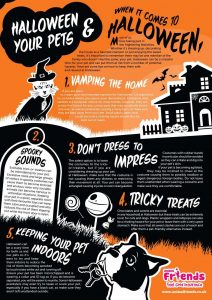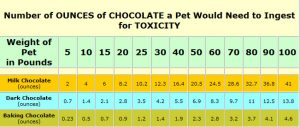
Steps to Keep Your Cat Safe This Halloween
Few things in life are cuter than seeing your cat in a pumpkin-colored collar complete with bells. But for cats and their families, Halloween should also be a time for caution. In order to ensure that both your children and cats enjoy a fun and safe holiday, please remember the following tips:
- Your cat can easily become anxious and frightened when the doorbell is constantly ringing and all she sees are children in strange clothes and masks. Confining her to her own safe haven for the evening (like a pet carrier or a closed room) can help calm her nerves and keep her from running out of the constantly opening front door.
- If you’re dressing your cat for Halloween, use safe, non-flammable and non-toxic items that your cat is comfortable in and that don’t restrict movement, breathing or vision.
- It’s best to keep cats indoors on Halloween, especially black cats. Many black cats end up missing on this night because of pranks or for other unspeakable reasons. It’s better to be safe than sorry.
- Lastly, keep all candy out of your cat’s reach — especially chocolate, which is toxic to cats.
- If you want to make homemade treats for your cat, try this recipe.
Following these simple tips will help keep your cat safe, healthy and out of any scary trouble this Halloween.
Halloween Safety Tips For Your Dog

There are few things in life cuter than seeing your terror-of-a-puppy dressed up in horns and a red cape on Halloween. But for dogs and their families, Halloween should also be a time for caution. To ensure that both your children and dogs enjoy a fun and safe holiday, please remember the following tips:
- Your dog can easily become anxious and frightened when the doorbell is constantly ringing and all he sees are children in strange clothes and masks. Confining him to his own safe haven for the evening (like his crate or a closed room) can help calm his nerves and prevent him from running out of the constantly opening front door.
- If you walk your dog around the neighborhood while children are trick-or-treating, be sure to use a sturdy collar, or harness and leash, and be careful around unfamiliar children and adults. Again, the costumes and masks may make your dog uncomfortable and frightened.
- Be sure your dog is wearing identification tags with your name and phone number on them in case you become separated from your dog or he escapes from the house.
- If you’re dressing your dog for Halloween, use safe, non-flammable and non-toxic items that your dog is comfortable in and that don’t restrict his movement, breathing or vision.
- Lastly, keep all candy out of your dog’s reach — especially chocolate, which is toxic to dogs. Consumption of even small amounts can cause seizures, muscle tremors and vomiting while larger doses can be fatal. Stick to his own treats and he’ll be just as happy.
15 DIY Treats You Can Make For Your Dog This Halloween

Halloween means a ton of chocolate. A ton of chocolate that your pup can’t have. Why not make Halloween their favorite holiday by giving them their very own array of yummy treats.
Howl-O-Ween Event: Meet & Greet + Costume Contest!

Halloween Meet & Greet & Costume Contest!
That’s right, it’s October and our friends at Pawsitive Plus Dog Training and Consulting Service Ltd are more than excited to host a costume contest get together event for Halloween, to kick off the opening of their new dog training location in Mississauga!! Woohoo!! So dress up your pup in the cutest.. or SCARIEST costume and join them!
With our new location officially opening really soon, they thought we would take the opportunity to have you and your pup meet the team, while they also get to know you and have some Halloween fun!
They will have prizes and more! As well as some tasty treats for everyone, not just your pups!
Halloween Dangers to Dogs & Cats

During the week of Halloween, calls to the veterinarians at Pet Poison Helpline increase by 12 percent, making it the call center’s busiest time of year. “Each year we experience a sharp increase in calls around Halloween, especially during the weekends surrounding the holiday,” said Ahna Brutlag, DVM, MS, assistant director at Pet Poison Helpline. “Most often, these calls involve pets accidentally ingesting Halloween candy or décor. Chocolate is one of the most problematic candies as dogs and cats cannot metabolize it as well as people. Thus, it places them at risk for poisoning.” The four most common food-related Halloween hazards for pets are chocolate, candy overindulgence, raisins and candy wrappers.
Chocolate
- Of all candy, chocolate is one of the most toxic to pets. Over the past year, more than 1,100 calls to Pet Poison Helpline involved exposure to chocolate and 98 percent of them involved dogs. Many dogs are inherently attracted to the smell and taste of chocolate, making it a significant threat. In general, the darker and more bitter the chocolate, the more poisonous it is. The chemicals in chocolate that are dangerous to pets, methylxanthines, are similar to caffeine and more heavily concentrated in the darker varieties. In fact, a 50-pound dog can be sickened by ingesting only one ounce of Baker’s chocolate! To avoid issues, keep Halloween candy well out of the reach of pets at all times. If you think your pet may have ingested chocolate, symptoms to watch for include vomiting, diarrhea, lethargy, agitation, increased thirst, an elevated heart rate, and in severe cases, seizures.
Candy
- Pets are indiscriminate when it comes to eating tasty treats and can gorge themselves on snacks and food meant for humans. Large ingestions of sugary, high-fat candy can lead to pancreatitis in pets. Potentially fatal, pancreatitis is inflammation of the pancreas and very painful. It may not show up for two to four days after the pet ingests the candy. Symptoms include decreased appetite, vomiting, diarrhea, lethargy, abdominal pain, and potentially, kidney failure or organ damage.
Grapes and Raisins
- Some people prefer to distribute healthy snacks instead of candy on Halloween, such as mini-boxes of raisins. These are extremely poisonous to dogs! Very small amounts of raisins (and grapes) can cause kidney failure in dogs and, potentially, cats. When it comes to your pets, raisins deserve the same pet-proofing treatment as chocolate – stored in secure containers far from their reach. Unfortunately, some dogs develop idiosyncratic reactions at any dose – in other words, they can ingest any amount and potentially be poisoned. Therefore, any ingestion of raisins or grapes should be treated as a “poisoning” case. Symptoms include vomiting, nausea, decreased appetite, lethargy, abdominal pain, and severe kidney failure.
Candy Wrappers
- Generally when pets eat candy, they don’t bother to remove the wrappers. Ingestion of foil and cellophane wrappers can cause a life-threatening bowel obstruction, which if severe, can require surgical intervention to correct. Watch for vomiting, decreased appetite, not defecating, straining to defecate, or lethargy. X-rays may be necessary to diagnose this problem.
Glow Sticks and Glow Jewelry
- Pets, especially cats, love to chew on these items. Over the past year, Pet Poison Helpline received nearly 80 calls concerning pets that punctured glow sticks or glow jewelry, and 70 percent of the calls involved cats. While not usually life-threatening, their contents can cause pain and irritation in the mouth, as well as profuse drooling and foaming at the mouth.
Costumes
- Pets look cute dressed in costumes, but they might not enjoy it as much as their owners. If you dress your pet in a costume, be sure it doesn’t impair his vision, movement or air intake. If the costume contains metallic beads, snaps or other small pieces, be aware that if ingested, some metals (especially zinc and lead) can result in serious poisoning. Also, don’t be tempted to dye or apply coloring to your pet’s fur. Even if the dye is labeled non-toxic to humans, it could still be harmful to pets.
Candles
- Keep candles out of the reach of curious noses and wagging tails. Sometimes pets don’t realize something is hot until they get burned.
During this Halloween season, help keep your pet safe. If you think your pet has ingested something poisonous, the veterinarians at Pet Poison Helpline suggest that you get help sooner than later. It’s always easier, less expensive, and safer for your pet to be treated earlier, versus when he’s showing severe symptoms. Contact your veterinarian or Pet Poison Helpline immediately at 855-764-7661.
